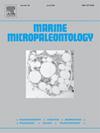来自移动基质的无孔有孔虫:隐藏的生物体和大错误-本质是肉眼看不到的
IF 1.5
4区 地球科学
Q2 PALEONTOLOGY
引用次数: 0
摘要
在巴西东南部内陆大陆架进行的两个案例研究显示,附着在沉积物颗粒上或包裹在沉积物颗粒中的有孔虫的丰度和多样性出乎意料。样品用孟加拉玫瑰染色,用福尔马林固定,用三氯乙烯浮选分离游离有孔虫。筛选后,对残余部分进行了严格检查,发现了许多附着的个体和强大的凝集形式,这些凝集形式将沉积物颗粒纳入其测试中。该动物群包括很少在未固结的移动基质中记录的鲜为人知的属。浮动分数和剩余分数之间的比较揭示了显着的差异,强调当剩余分数被忽视时,对坚固和坚固形式的低估。正如稀薄曲线所示,忽略这些形式可能会损害环境和古环境的解释,特别是在高水动力区域,通常被视为动物群的挑战环境。本研究强调了将无孔有孔虫纳入动态海域生物多样性评估的重要性。我们为Murray(1973)的三元图提出了一个新的区域,即“高流体动力内海岸架”。此外,我们的研究结果表明,不适当的筛选方法可能会在分类记录中留下重大空白。许多附着有孔虫仍然是研究人员“看不见的眼睛”,往往是由于它们的形状,缺乏先验知识,或注意不足,导致低估了它们的密度和丰富程度。因此,这些生物在环境表征、分类记录,特别是在古生态学研究和监测工作中经常被忽视。本文章由计算机程序翻译,如有差异,请以英文原文为准。

Sessile foraminifera from mobile substrates: Hidden organisms and big mistakes – The essential is invisible to the eyes
Two case studies conducted on the inner continental shelf off southeastern Brazil revealed an unexpectedly high abundance and diversity of foraminifera attached to or encrusted in sediment grains. Samples were stained with Rose Bengal, fixed in formalin, and subjected to trichloroethylene flotation to isolate free foraminifera. Following screening, the residual fraction was rigorously examined, uncovering numerous attached individuals and robust agglutinate forms that incorporate sediment grains into their tests. This fauna includes little-known genera rarely documented in unconsolidated mobile substrates. Comparisons between floated and residual fractions revealed notable discrepancies, emphasizing the underestimation of sessile and robust forms when residual fractions are overlooked. Neglecting these forms can compromise environmental and paleoenvironmental interpretations, as rarefaction curves illustrate, particularly in high-hydrodynamic regions typically seen as challenging environments for fauna. This study underscores the importance of including sessile foraminifera in biodiversity assessments in dynamic marine areas. We propose a new zone, the “high-hydrodynamic inner coastal shelf,” for Murray's (1973) ternary diagram. Additionally, our findings indicate that inadequate screening methods may leave significant gaps in taxonomic records. Many attached foraminifera remain “invisible to the eye” of researchers, often due to their shape, a lack of prior knowledge, or insufficient attention, resulting in underestimations of their density and richness. Consequently, these organisms are often overlooked in environmental characterizations, taxonomic records, and especially in paleoecological studies and monitoring efforts.
求助全文
通过发布文献求助,成功后即可免费获取论文全文。
去求助
来源期刊

Marine Micropaleontology
地学-古生物学
CiteScore
3.70
自引率
15.80%
发文量
62
审稿时长
26.7 weeks
期刊介绍:
Marine Micropaleontology is an international journal publishing original, innovative and significant scientific papers in all fields related to marine microfossils, including ecology and paleoecology, biology and paleobiology, paleoceanography and paleoclimatology, environmental monitoring, taphonomy, evolution and molecular phylogeny. The journal strongly encourages the publication of articles in which marine microfossils and/or their chemical composition are used to solve fundamental geological, environmental and biological problems. However, it does not publish purely stratigraphic or taxonomic papers. In Marine Micropaleontology, a special section is dedicated to short papers on new methods and protocols using marine microfossils. We solicit special issues on hot topics in marine micropaleontology and review articles on timely subjects.
 求助内容:
求助内容: 应助结果提醒方式:
应助结果提醒方式:


